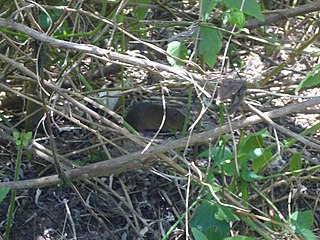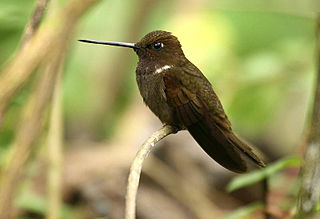
Oxymycterus is a genus of rat-like rodents commonly known as hocicudos. They are endemic to South America. As of April 2019, the genus contains the following 16 species:
The angular hocicudo is a rodent species from South America. It is found in Brazil.
The hispid hocicudo is a rodent species from South America. It is found in Argentina and Brazil, in the Atlantic Forest.

The long-nosed hocicudo is a South American rodent species found in southeastern Brazil and Uruguay.
Robert's hocicudo is a rodent species from South America. It is found in Brazil and Paraguay.

The red hocicudo is a rodent species from South America. It is found in Argentina, Brazil and Uruguay.

The brown inca is a species of hummingbird in the "brilliants", tribe Heliantheini in subfamily Lesbiinae. It is found in Colombia and Ecuador.
The shining thicket rat is a species of rodent in the family Muridae.
The Argentine hocicudo is a species of rodent in the family Cricetidae. It is found only in northern Argentina in yungas habitat. The exact population is unknown as only three specimens have been collected and threats may be deforestation and overgrazing although the exact effects are unknown. Some authorities consider it to be conspecific with Oxymycterus paramensis, while others consider it distinct.
The spy hocicudo is a species of rodent in the family Cricetidae. It is found only in Paraguay.
The small hocicudo is a little known species of rodent in the family Cricetidae. It is found in Bolivia and Peru on the eastern slopes of the Andes.
Oxymycterus hucucha, also known as the Quechuan hocicudo, is a species of rodent in the genus Oxymycterus of family Cricetidae from South America. It is found only in a small region of the Andes in central Bolivia, where it lives in cloud forest at altitudes from 2600 to 3000 m.
The Paramo hocicudo is a species of rodent in the family Cricetidae. It is found in Argentina, Bolivia, and Peru. The Argentine hocicudo is sometimes considered conspecific.

The bronzy inca is a species of hummingbird in the "brilliants", tribe Heliantheini in subfamily Lesbiinae. It is found in Bolivia, Colombia, Ecuador, Peru, and Venezuela.

The black inca is a species of hummingbird in the "brilliants", tribe Heliantheini in subfamily Lesbiinae. It is endemic to Colombia.

The Incan caenolestid, also known as the Incan shrew opossum or Peruvian caenolestid, is a caenolestid found in the southern Peruvian Andes. It was first described by English zoologist Oldfield Thomas in 1917. The head-and-body length ranges from 9 to 11.5 centimetres, and the weight is between 25 and 32 grams. It is brown on the back, and lighter on the underside. Little is known about the behaviour of the Incan caenolestid; it appears to be terrestrial and nocturnal. It feeds on small invertebrates and insects. This caenolestid inhabits elfin and secondary forests. The IUCN classifies it as least concern.
The Atlantic Forest hocicudo is a species of rodent in the family Cricetidae. It is found only in southeastern Brazil, where it lives in the Atlantic Forest and associated wetlands at altitudes from sea level to 800 m (2,600 ft).
Cook's hocicudo is a species of rodent in the family Cricetidae. It is found only in southern Uruguay, where it lives in wetlands, moist grasslands and scrub. The specifies is named after American zoologist Joseph "José" A. Cook.
The quaestor hocicudo is a species of rodent in the family Cricetidae. It is found in southeastern Brazil and northeastern Argentina, where it lives in forest and moist and dry scrub.
The ravine hocicudo is a rodent species from South America. It is found in Argentina.






